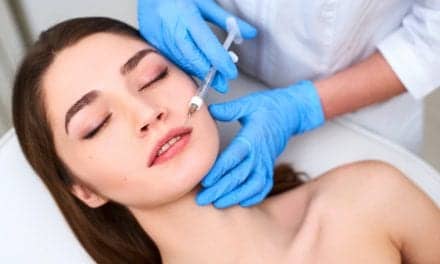 |
A beautiful smile has become a symbol of health, happiness, and, simply, beauty. Teeth-whitening companies have proliferated over the last decade, as has the popularity of cosmetic dentists, dental treatments, and related products.
One aspect of a beautiful smile is consistently overlooked, and that is the impact of an asymmetrical smile. Many people are self-conscious of their smile because it is asymmetrical, gummy, or uneven.
These people may go so far as to avoid social situations, cover their mouths with their hands, avoid smiling at all, or will constantly look down or purse their lips.
The surgical correction of a lopsided smile may not be an option for some, due to its high cost or possibly because they want to avoid surgery. Many people don’t even realize that there may be a solution to their problem.
Although the man on the street with a normal smile may never think about this issue, aesthetic surgeons should watch for it. However, we may overlook it because we just aren’t looking for it. To make matters worse, the patient may not mention it because she is unaware of the fact that her lopsided smile could be corrected by a simple injection of botulinum toxin Type A.
CASE STUDY
I treated a patient a few months ago for lip enhancement. Once given Restylane and pleased with the result, she left the office. During the injection, she commented that she had uneven lips and that they may be difficult to even out because of their shape.
A few years before her visit, she was in a motor vehicle accident that affected the innervation of her lips, so that one side was weaker than the other. Her smile was now lopsided. She simply couldn’t elevate the right side of her lip normally when smiling. Even when she was at rest, her defect could be clearly seen.
A few days after she received the Restylane lip enhancement, her son called to say that the lip enhancement had brought more attention to her asymmetrical smile. Her son wanted to know if anything could be done about it.
After carefully examining her in my office, I determined that the defect was a weakened upper lip elevator on her right side. The upper lip elevators include the levator labii superioris, the levator labii superioris alaeque nasi, the Zygomaticus major and minor, the levator anguli oris, and the Risorius.
I administered two units of botulinum toxin Type A into the body of the left levator labii superioris muscle. I placed this injection around 1 cm below the orbital rim near the ocular foramen, near the origin of the muscle.
The midline depressor septi muscle also plays a role in lip elevation. When determining which muscle was affecting her lip asymmetry, I watched her smile carefully to ascertain, as closely as possible, which muscle group was involved.
Many different lip asymmetries exist. They may involve the lip elevators or lip depressors. Careful evaluation and knowledge of lip anatomy and muscle function must be carried out prior to injection.
The muscle’s course should be outlined so that the correct muscle group is targeted. The injection must also be placed where it will not migrate to other muscle groups, which would result in too much lip elevation or depression—or worse, give the patient a completely different asymmetry.
Once identified and isolated, the muscle should be injected with as small amount of botulinum toxin Type A as possible to see if the correct elevator or depressor has been found and to avoid overcorrection of the defect.
I dilute my botulinum toxin Type A with 1 cc of preserved saline, which gives me increased control over the amount injected.
I injected two units of botulinum toxin Type A directly into the patient’s muscle and achieved perfect balance of her smile. I suggest that most often one should start with just one unit, wait a week or so, and then see the patient again and confirm the effect of the injection.
This way, if the wrong muscle group was targeted or the muscle was not injected in the best location, not much harm is done. You can either wait until the botulinum toxin Type A wears off, or try to pinpoint the injection site more precisely and try again.
LIP IMBALANCE
Many patients will present you with an asymmetrical smile due to an imbalance of the lip depressors. However, one of this patient’s lip elevators was weak. Ask the patient to maneuver his or her lips into several facial expressions to help to identify the muscles involved. This way, you can more precisely achieve your intended aesthetic goal.
The proper relaxation or balancing of the antagonistic muscles of the lip elevators and depressors will help you gain profound improvements in the patient’s appearance.
|
See also “The New Therapy Landscape” by Wendy Lewis in the April 2007 issue of PSP. |
At around that same time that the asymmetrical-smile patient presented, my nurse approached me about her gummy smile with the hope that I could also help her. When she smiled, a disproportionate amount of gum showed. She admitted to feeling self-conscious when she smiled, and, as a result, was often reluctant to do so.
This is a separate and different problem from the asymmetrical smile discussed above, but it is just as embarrassing to the patient. Again, careful assessment of the affected smile will allow you to target the muscle, select the proper treatment, and determine the correct amount of botulinum toxin Type A to administer to weaken the muscles responsible for this unattractive exposure of gum.
I encourage all physicians who perform botulinum toxin Type A injections to look out for these problems. Correction will bring great pleasure and satisfaction to your patients and could offer them a tremendous improvement to their lifestyles.
Dolores Kent, MD, FACOG, is certified by the American College of Obstetrics and Gynecology, and is a member of the American Academy of Cosmetic Surgery. She can be reached at or (310) 860-9490.




